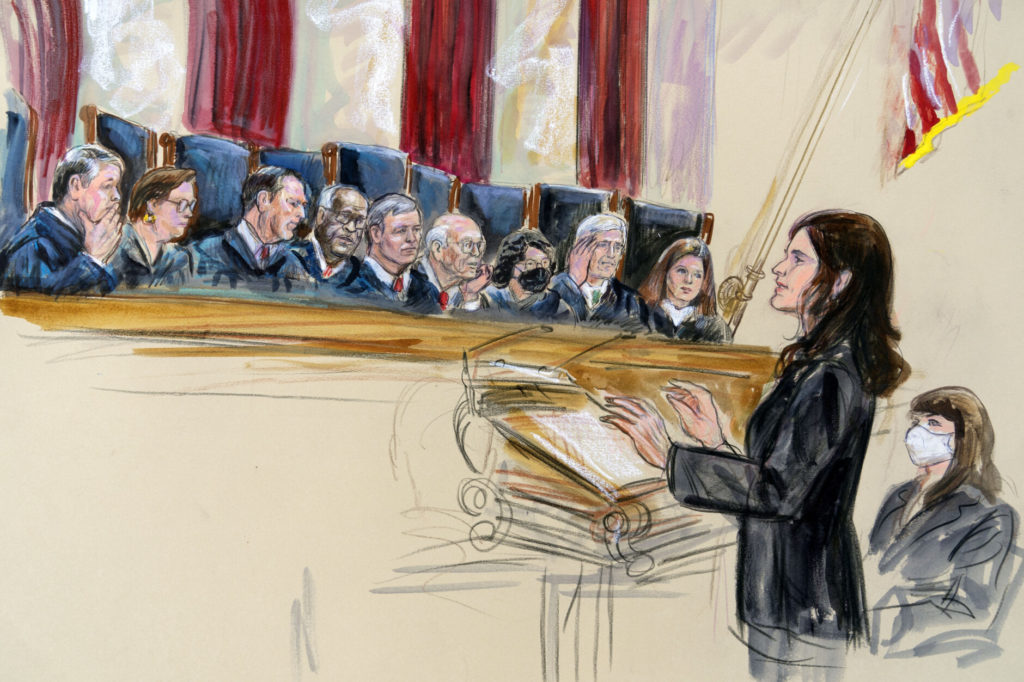How the sausage gets made

I’m sure sooner rather than later we’ll get an inside-baseball story about today’s opinion cancelling Section 3 of the 14th Amendment. But we already have the broad strokes because the Court forgot to scrub the metadata from the electronically published opinion:
The Supreme Court’s decision on Monday to keep Donald Trump on Colorado’s ballot was styled as a unanimous one without any dissents. But the metadata tells a different story. On the page, a separate opinion by the liberal justices is styled as a concurrence in the judgment, authored jointly by the trio. In the metadata of the link to the opinion posted by the court, however, this opinion is styled as an opinion concurring in part and dissenting in part, authored not by all three justices but by Sonia Sotomayor alone. Even a techphobic reader can discern this incongruity through careful copying and pasting, piercing the facade of unanimity that the conservative justices sought to present.
What happened? Most obviously, the Supreme Court rushed out this opinion and forgot to check the metadata. The court, after all, scheduled the opinion’s release only one day earlier, on Sunday afternoon, evidently to hand it down before Tuesday’s Colorado primary. Moreover, the justices did not take the bench to announce the opinion, as they usually do—probably because they had not all planned to be in D.C.—further proving that it was a last-minute release. The deeper question remains, of course: Why was an opinion originally authored by a lone justice as a partial dissent transformed into a concurrence authored by all three liberals together?
[…]
Which leads to a second question: Why did a stand-alone Sotomayor dissent transform into a three-justice concurrence? Here, the most rational intuition is that Kagan and Jackson were keeping their votes fluid in the hopes of striking a bargain to avert a gratuitously broad opinion effectively repealing the insurrection clause. This bargain may have been simple; the two justices might have joined with Barrett to seek a fifth vote for a narrow holding, presumably from Roberts. All the while, Sotomayor worked on the fallback option: a partial dissent chastising the majority’s overreach. When Kagan and Jackson realized they couldn’t nab a fifth vote for the narrow position, they teamed up with Sotomayor, making a few changes and signing their names as authors in a show of force and agreement within the progressive bloc. (The description of presidential elections as “a great and glorious thing,” for example, sounds like the work of Kagan or Jackson, not Sotomayor.)
Broaden the scope of the potential negotiations, though, and things get more interesting. After oral arguments, many smart court watchers mused that the justices might reach a grand bargain that tied this case to a separate dispute involving Trump’s claim of immunity from criminal prosecution for election subversion. The liberal justices might agree to keep Trump on the ballot if the court also refused to take up the immunity case. There would be an exchange of votes: Trump stays on the ballot but gets no immunity from prosecution. He could run in all 50 states but would also have to contend with a criminal trial that would likely conclude before the election.
That, of course, didn’t happen: The court sided with Trump on the ballot issue and took up his immunity case last week on a less-than-speedy timeline, helping him run out the clock to November. But maybe Kagan and Jackson were working behind the scenes to strike this grand bargain. Maybe they were withholding their votes in both cases, scrambling to find two conservative justices who would rule narrowly for Trump in one case and swiftly against him in the other. If so, that didn’t happen. But it would still make sense for Kagan and Jackson to withhold their votes in both cases until they got confirmation that no compromise lay on the horizon in either dispute.
ACB’s decision to file an embarrassing Reverend Rodney King Jr. concurrence made it pretty evident that there was an effort to get Roberts on board for a more minimalist opinion for the Court, and two of the liberals keeping their votes open until late in the process would seem to confirm that. I hadn’t really considered the possibility that it was part of a larger negotiation over the immunity case, but it’s certainly plausible.
I’m reminded that when I pointed out that it was an obvious inference that Breyer and Kagan voted strategically in joining Roberts’s ridiculous Medicaid expansion holding, multiple lawyers in comments were very offended at the very idea that a Supreme Court justice would ever cast a non-sincere vote to achieve a better overall outcome (even though strategic voting on the Court was dispositively demonstrated with evidence from internal court documents by political scientists before “(I Can’t Get No) Satisfaction” was released.) Still believing in Santa Claus at this point is pretty marginal, wouldn’t you say?


